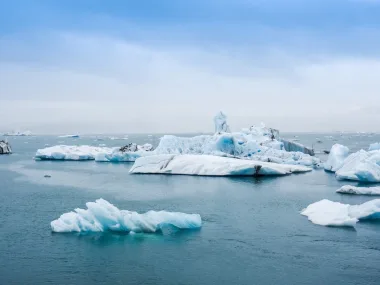Last Updated on May 14, 2024 by Ecologica Life
Big news for our planet: a study in the journal Nature Climate Change reveals that between a quarter and half of the world’s vegetated areas have become significantly greener over the past 35 years.1
The main reason? Rising levels of CO2 in the atmosphere. The pumping of CO2 into the atmosphere is usually a story of doom and gloom in our news media, but few have considered the unintended benefits of extra CO2 in the atmosphere.
Table of Contents
The Study
A huge international team of 32 researchers and 24 institutions across eight countries carried out an exciting study. They used state-of-the-art satellite data from NASA’s Moderate Resolution Imaging Spectrometer and NOAA’s Advanced Very High Resolution Radiometer to measure the leaf area index.
Put simply, they used advanced instruments to determine the leaf area index, or the amount of leaf cover, over the planet’s vegetated regions.
How Much Greening Has Occurred?
What they found was pretty incredible: the amount of new leaves on plants and trees is equivalent to twice the area of the continental United States.
How Did This Happen?
Considering the evil villain that carbon is often portrayed as, this development is very surprising. The question is, how did it happen?
Plants are quite magical when you think about it. They use sunlight for photosynthesis, converting CO2 from the air, along with water and nutrients from the soil, into sugars. These sugars are vital as they form the basis of the food, fibre and fuel that sustain life on Earth. Research has shown that higher CO2 levels boost this process, which in turn promotes plant growth.
But it’s not just about more CO2. Other factors such as nitrogen concentration, changes in land use, and shifts in climate conditions such as temperature, rainfall, and sunshine also play a role in the global ‘greening’ phenomenon.
To understand how much of this greening can be attributed to carbon dioxide alone, scientists ran the data for carbon dioxide and each of the other variables in isolation, using computer models that mimic the plant growth observed in the satellite data.
The findings? Carbon dioxide is the main player, responsible for 70% of the greening effect. Nitrogen comes in second, accounting for 9% of the greening effect.
This effect is part of what’s known as the CO2 fertilisation effect. The CO2 fertilisation effect is complex and some of its effects are controversial. We will therefore look at the CO2 fertilisation effect in more detail in another article.
What are the Benefits and Downsides?
The benefits are a boom in plant life across the planet. Especially in areas where there was little plant life before, such as the Arctic. The CO2 fertilisation effect has been reported to be responsible for 44% of gross primary productivity (GPP) increase since the 2000s.2 GPP is the synthesis of organic compounds from the atmosphere.
The CO2 fertilisation effect has partially mitigated some of the effects of climate change.3 Although it seems unlikely that this effect will significantly reduce the amount of CO2 pumped into the Earth’s atmosphere.
What it does suggest is something of a feedback or response to increasing levels of CO2 in the Earth’s atmosphere. The late James Lovelock put forward the theory of ‘Gaia’ (Earth), which suggests that the Earth is (or behaves like) a living thing. It is almost as if the Earth is responding to increased CO2 emissions.
As a potential downside, it has been suggested that increases in atmospheric CO2 may reduce the nutritional quality of some crops. Wheat, for example, could see a reduction in its protein, iron and zinc content.
In addition, the long-term sustainability of the CO2 fertilisation effect is still being studied. We don’t know if ecosystems have a saturation point where they no longer respond to increased CO2 in the same way.
Conclusion
I think that more work needs to be done to assess the pros and cons of the CO2 fertilisation effect. I intend to do more research on this myself to see if I can come to more solid conclusions.
I think this study should serve as a reminder to both scientists and the general public alike that we shouldn’t just look for bad outcomes to a problem, especially if we only expect bad outcomes. There are always unintended consequences of an action. If you expect positive results, stop and ask yourself, what the negative consequences might be, and vice versa.
I would also like to point out that this study was published in 2016 and has received very little media coverage. I think that’s because it doesn’t fit into the current climate change narrative.
Climate change is a topic that needs to be taken seriously, and to do that we need to honestly examine all aspects of it. It doesn’t make you a ‘climate change denier’ just because you look at positive outcomes, in fact, it seems to me that the opposite is true in this case.
Share this article so we can show others that humans can have a good impact on the environment, not just a bad one. Let us know what you think in the comments.
References
- Zhu, Z., Piao, S., Myneni, R. et al. Greening of the Earth and its drivers. Nature Clim Change 6, 791–795 (2016). https://doi.org/10.1038/nclimate3004
- Chen C, Riley WJ, Prentice IC, Keenan TF. CO2 fertilization of terrestrial photosynthesis inferred from site to global scales. Proc Natl Acad Sci U S A. 2022 Mar 8;119(10):e2115627119. doi: 10.1073/pnas.2115627119. Epub 2022 Mar 1. PMID: 35238668; PMCID: PMC8915860.
- Wang, Songhan et al. (2020). Recent global decline of CO 2 fertilization effects on vegetation photosynthesis. 370(6522). https://doi.org/10.1126/science.abb7772

 Kaine Moreno McDaid – Scientist, Researcher & Science Communicator
I am a biomedical scientist and researcher with a passion for scientific discovery and knowledge-sharing. With experience in immunology and public health research, I have recently co-authored a study on COVID-19 and its dietary impacts. Now, I apply my research expertise and analytical skills to creating insightful, science-backed environmental content.
Through my writing, I aim to bridge the gap between science and everyday life, empowering people with accurate, well-researched information to make informed and sustainable choices. I believe that truth has immense value, and we have a responsibility to explore, discuss, and share it.
Kaine Moreno McDaid – Scientist, Researcher & Science Communicator
I am a biomedical scientist and researcher with a passion for scientific discovery and knowledge-sharing. With experience in immunology and public health research, I have recently co-authored a study on COVID-19 and its dietary impacts. Now, I apply my research expertise and analytical skills to creating insightful, science-backed environmental content.
Through my writing, I aim to bridge the gap between science and everyday life, empowering people with accurate, well-researched information to make informed and sustainable choices. I believe that truth has immense value, and we have a responsibility to explore, discuss, and share it.
 Interests: Biomedical Science | Immunology | Nutrition | Environmental Sustainability | Scientific Communication
Interests: Biomedical Science | Immunology | Nutrition | Environmental Sustainability | Scientific Communication 






